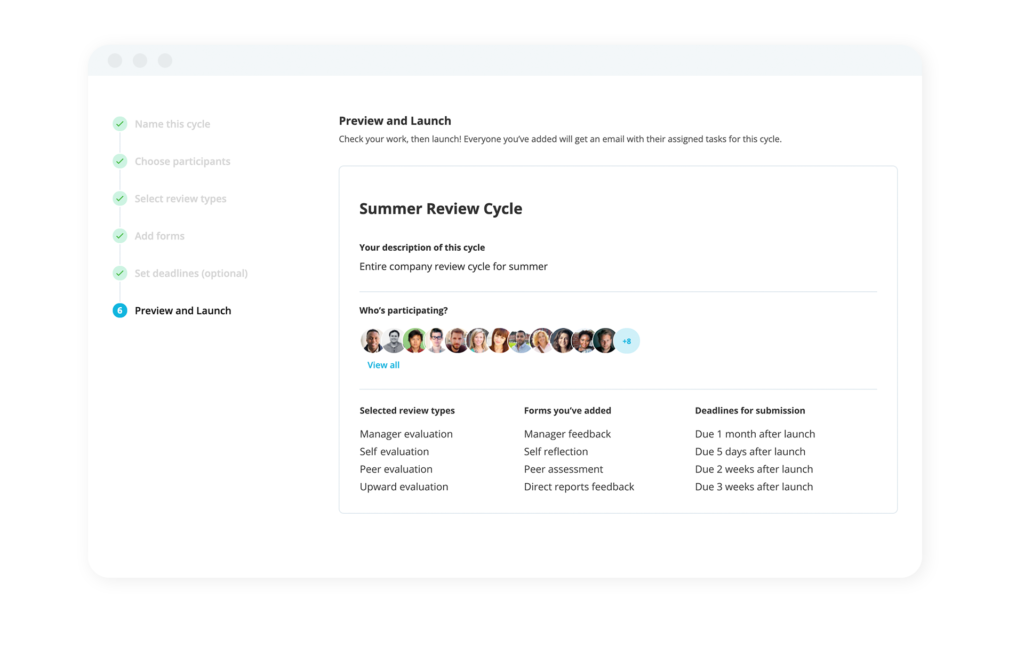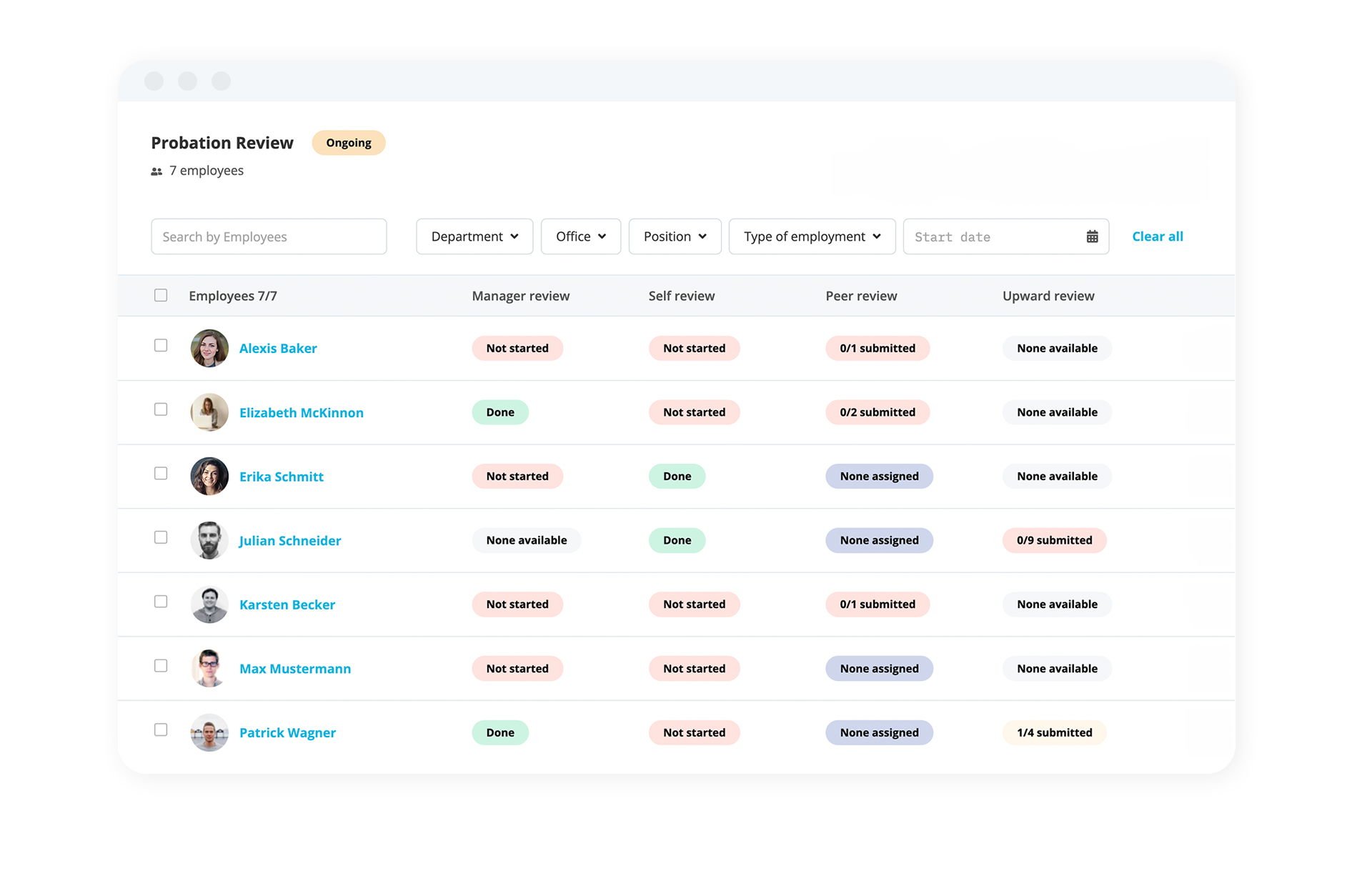
Automated Performance Cycles
Run an automated performance cycle that really works.
Performance Cycles With Personio360 Review How-to Guide: Benefits & Best Practices
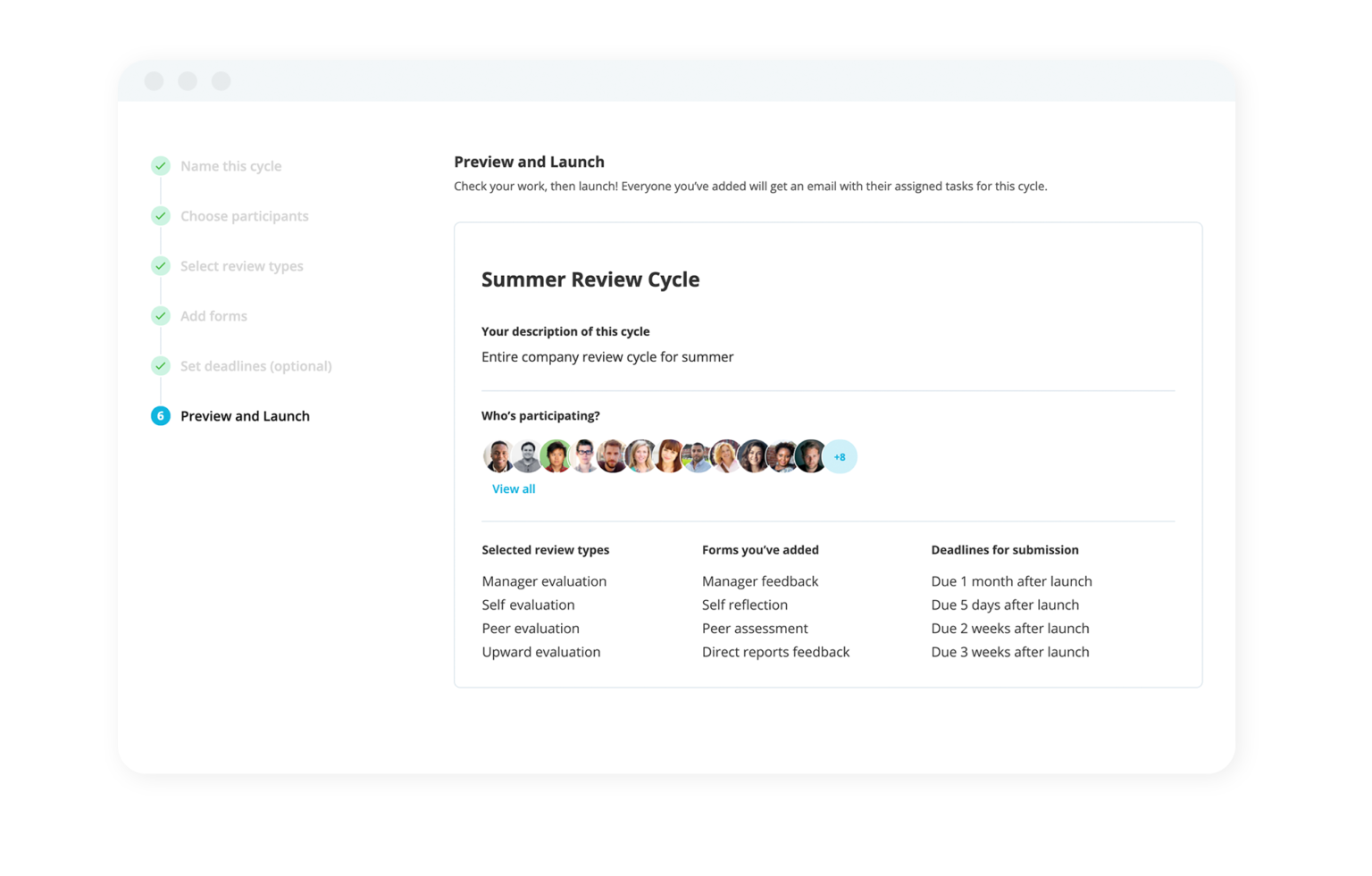
A 360 review can give you a much more holistic and accurate view of an employee’s skills and performance. In a traditional performance review, employees are reviewed by their direct manager or supervisor. But, managers don’t always have a clear picture of every aspect of an employee’s work.
That means that these kinds of reviews are often inaccurate, or incomplete at best. Read on for our full guide to how 360 reviews can change things for the better.
Start from the top with our performance review template today.What is a 360 review?
A 360 review is a type of performance review that gathers feedback on an employee’s performance from multiple sources. This typically includes their manager, reports, colleagues and various other stakeholders in or outside of an organisation.
Unlike more traditional performance reviews that are typically conducted between a manager and their report, the purpose of a 360 performance review is to offer a more holistic (and therefore more accurate) view of an employee’s performance.
Some key facts about 360 reviews include:
360 reviews encompass numerous types of feedback from all directions instead of just from an employee’s direct manager.
While 360 reviews can be complex and time-consuming to organise, they typically produce better results than traditional reviews.
360 reviews can help pinpoint areas for improvement both individually and on an organisational level.
What is the goal of a 360 review?
The goal of a 360 review is to give managers and employees a holistic, accurate understanding of an employee’s performance, and help them to identify areas for improvement.
Are 360 reviews anonymous?
360 reviews should almost always be anonymous because this helps people to feel comfortable giving honest feedback. However, some organisations give employees the option of attaching their names to a comment if they feel it would be useful.
Types of 360 performance reviews
There are two major types of 360 reviews that you could implement at your organisation:
1. Episodic 360 Reviews
An episodic 360 review is typically carried out on senior employees as part of a leadership development programme. They are usually quite in-depth and involve getting input from dozens of people.
For this reason, episodic 360 reviews usually require the assistance of a coach or assessment expert to interpret the responses. An expert can help you distil feedback into a format that’s easy to understand.
2. Periodic 360 Reviews
Periodic or regular 360 reviews are generally performed for all employees as part of their annual performance reviews.
For this reason, they tend to be a bit less in-depth than episodic 360 reviews. However, they still require input from a number of people and can be challenging to organise.
The biggest benefits of 360 reviews
Here are some of the biggest benefits of conducting 360 reviews over other performance evaluation methods:
Feedback from a variety of sources - Employees can understand performance in relation to different stakeholders. For example, an employee might receive a positive review from their manager, but less positive feedback from their direct reports.
Higher quality feedback overall - Not all managers are skilled at giving feedback. 360 reviews give every employee the opportunity to receive constructive feedback that could help them improve.
Pinpointing areas of development - If an employee’s manager, direct reports and colleagues all mention that the employee has problems with prioritising their workload, it’s clear that this is something they need to work on.
Identifying organisational improvements - If multiple reviews reveal problems with leadership, the company could address the situation by providing training for managers to help them improve in their abilities.
Increasing trust from employees - A 360 review gives employees a more well-rounded view of their overall performance. This makes them more likely to believe that the feedback they receive is accurate — whether positive or negative.
Performance Review Template: Host More Productive Conversations

Add more structure to your performance conversations today. Download our templates to help guide the conversation.
Download NowPotential drawbacks of 360 reviews
Of course, there are also some downsides to conducting 360 reviews. Here are some of the cons of this method:
Time-consuming and difficult to implement - 360 reviews can become unwieldy and difficult to manage if you don’t have a proper system in place for gathering and curating feedback. You may want to start with a pilot group of employees.
Less effective with fewer respondents - If you have too few participants, you might end up with feedback that’s too narrow — and therefore inaccurate.
Requires effective change management processes - If you want to see real change in your organisation, conducting 360 reviews alone isn’t enough. You also need to invest in building a culture that promotes development, humility and the desire to improve.
Five steps to implement a 360 review process
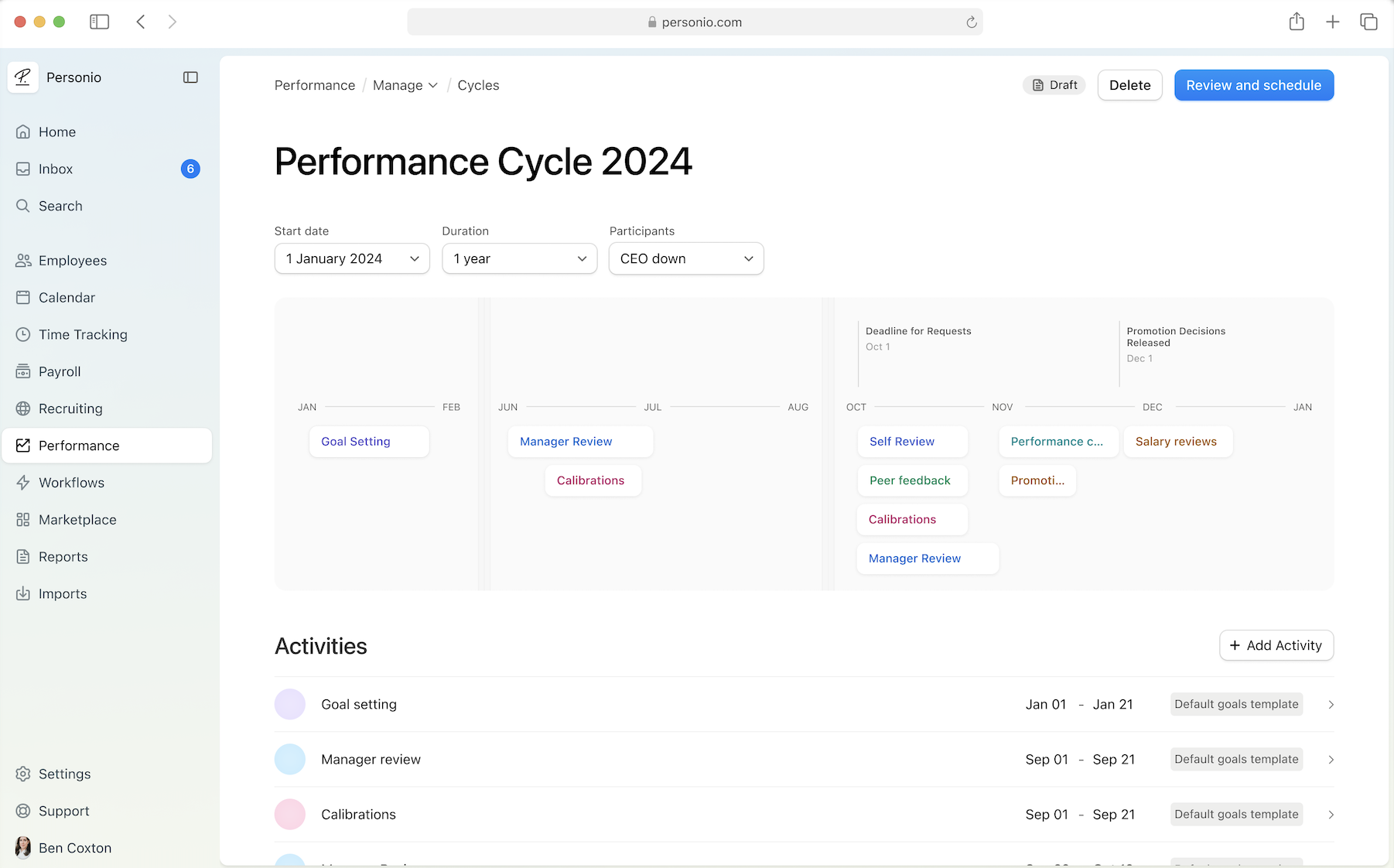
Here are the basic steps to follow if you want to implement a 360 performance review programme at your organisation:
Build your framework: This involves putting together the necessary documentation and deciding things like who will receive a review and how you’ll roll out the programme.
Choose your HR software: You’ll use this software to automate performance cycles and make it easy for employees to give and receive feedback.
Request reviews: Use your software to request feedback from each employee’s manager, coworkers, reports and anyone else whose views you think would be helpful.
Collect and collate feedback: It’s important to package the information in a way that makes sense to the employee and gives them an overall view of the feedback you’ve received.
Share the feedback with the employee: Work with them to define action steps and discuss how they’ll work on any areas for improvement that have been identified.
For a more in-depth guide to putting together your 360 feedback programme, as well as some sample questions and advice on building your own, read our full guide to 360 feedback.
A well-executed 360 review process can be a powerful tool for employee development. Here's a breakdown of key steps to ensure an effective review:
How to conduct an effective 360 performance review
A well-executed 360 review can be a powerful tool for employee development, almost as or more powerful than conducting a traditional performance review. Here's a breakdown of key steps to ensure an effective review:
1. Define objectives and purpose
Clearly outline why you're conducting the review. Is it for overall performance evaluation, development planning, or a specific skill set? Your objectives should be aligned with your company goals and the individual's overall role.
Best practice: Align your reviews to your overarching company values or vision to serve as your North Star for picture-perfect performance.
2. Establish rating criteria

Develop a clear framework for evaluating performance. Use a mix of core competencies relevant to the role and specific behavioural indicators for each competency. Your critera should be specific, measurable, achievable, relevant, and time-bound (SMART).
Best practice: Rating employees is a bit of a tricky subject. We'd recommend really intentionally choosing which rating system makes sense for your teams.
3. Select your stakeholders
Select a well-rounded group to provide feedback, including direct supervisor, peers, subordinates (if applicable) and internal clients (if relevant). Consider the scope of the employee's role and ensure confidentiality throughout the process.
Best practice: Think about how you structure your reviews and include participants, then think about how you educate them to be active participants in the process.
4. Develop and deliver feedback
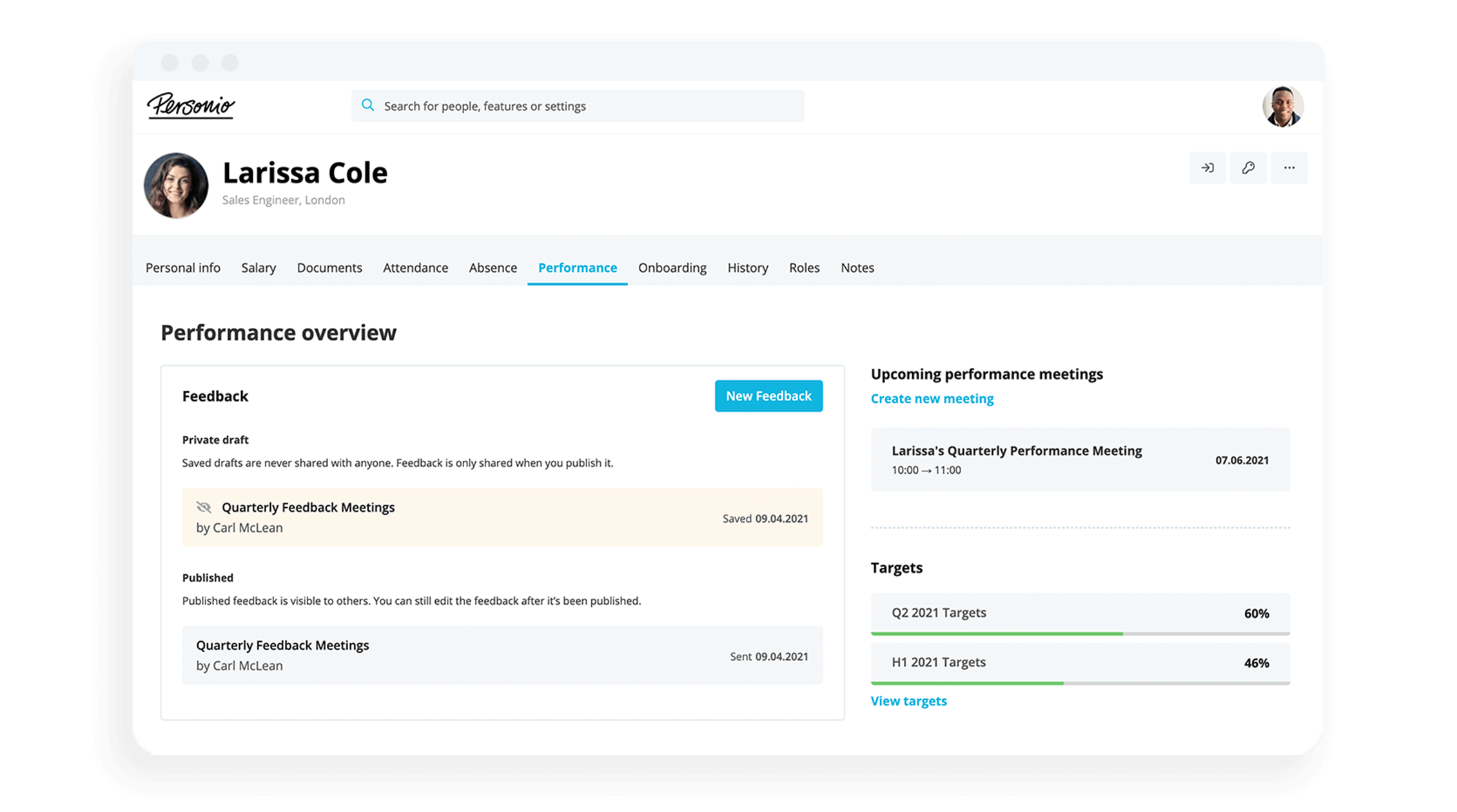
Use standardised solution with clear instructions and anonymous options to encourage honest feedback. Tailor your prompts to help encourage people to give feedback within a similar framework (and reduce fatigue while increasing adoption).
Best practice: Organisation-wide training on the art of giving feedback can be super helpful to adoption rates. It can give people a "shared language" for giving feedback.
5. Collect, analyse and summarise feedback
Provide a secure and accessible platform for participants to submit feedback. Emphasise confidentiality and the importance of constructive criticism. Identify recurring themes and patterns across the feedback. Look for both strengths and areas for development.
Best practice: Consider setting a clear deadline for feedback submission and ensure a high participation rate (ideally, 70% or more).
6. Craft a development programme
Collaboratively create a development plan with the employee based on the feedback received. Set SMART goals and identify resources for improvement. The plan should be clear, achievable, and aligned with the employee's career aspirations.
Best practice: Employees need to be as involved as possible when it comes to their own development. Give them the opportunity to self-direct their feedback, and then iterate with their manager, to increase adoption and reaching collective goals.
7. Follow up and monitor progress
Schedule regular check-ins to discuss progress on the development plan and offer ongoing support. Regular follow-ups demonstrate commitment to the employee's growth and hold them accountable for their goals.
Best practice: This stage is where embedding a culture of continuous feedback can truly move the needle for your organisation. Encourage people to collect feedback based on feedback they've received in the past to show marked improvements.
360 review do's and don'ts
Aspect | Do | Don't |
|---|---|---|
Providing Feedback | Be honest and specific. Use concrete examples to illustrate strengths and weaknesses. Frame feedback constructively, offering suggestions for improvement. | Sugarcoat feedback or avoid giving negative feedback altogether. Make personal attacks or focus on irrelevant details. |
Receiving Feedback | Maintain a positive and open mind. Acknowledge strengths and thank providers for their feedback. Focus on understanding the feedback and identifying areas for growth. | Become defensive or argumentative. Try to identify who provided specific feedback. Dwell on negative feedback and lose sight of the bigger picture. |
Confidentiality | Ensure the anonymity of feedback providers. Aggregate and summarise feedback before sharing with the employee. Use the feedback for development purposes, not for performance evaluation solely. | Reveal the identity of feedback providers. Share raw, unfiltered feedback with the employee. Use the feedback for punitive measures. |
Preparation | Clearly define the objectives and purpose of the review. Establish rating criteria that are specific and measurable. Select a well-rounded group of stakeholders to provide feedback. | Rush into the process without a clear plan. Use generic rating criteria that lack clarity. Only involve direct supervisors in the feedback process. |
Follow-up | Schedule a meeting to discuss the feedback with the employee. Collaboratively develop a development plan based on the feedback received. Regularly follow up on progress and provide ongoing support. | Neglect to discuss the feedback with the employee. Fail to create a concrete plan for improvement. Leave the employee without support after the review. |
Streamlined performance with Personio

Using Personio, managers and employees will be automatically prompted when it’s time to complete their reviews. You can create custom, standardised appraisal forms and rating scales to make sure the feedback you receive is measurable, useful and constructive.
Once reviews are in, you’ll be able to view the results in an easy-to-understand visual format, giving you a bird’s eye view of performance across your organisation.
Want to see what else Personio can do? Request a demo today.
